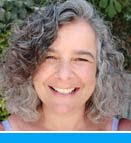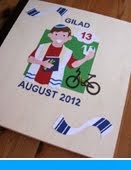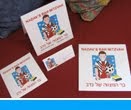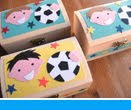It's been some time now since my eldest son's Bar Mitzvah but I've been holding off on showing his card because I didn't want my blog to become "The Bar Mitzvah blog". It does seem like I have posted a lot of Bar Mitzvah related projects lately, be they for my own son or for other boys of his age, but the Bar Mitzvah year has come to an end now for my son and his friends. I won't be posting anything else about family Bar Mitzvahs until... well... until my youngest son is Bar Mitzvah in two year's time! There will definitely be some Bar Mitzvah albums to see here though. I am currently hiding a couple away until the dates of the celebrations have passed.
The card I made for Nadav, above, displays his name prominently in Hebrew. A few of Nadav's friends had their Bar Mitzvahs after him. They were the youngest kids in the school year. Of course I made cards for them too, with similar symbols on them. On each card I added a black and white striped tallit, the Jewish prayer shawl. The tallit is a rectangular-shaped piece of linen, wool, or silk with special fringes called tzitzit on each of the four corners. A Jewish boy who has reached the age of 13 wears a tallit for morning prayer, during the week, as well as on Shabbat and other holy days.
I have already blogged about the design I created for my son's invitation, but am showing it here once again since it illustrates how the tallit is worn, draped over the shoulders like a cape.
Next to the tallit on each of the cards is a Sefer Torah. The Sefer Torah, or Torah Scroll, contains The Five Books of Moses, hand written on parchment (animal skin). The Sefer Torah is kept in the Ark in the Synagogue and portions are read from it publicly on Shabbat, Holidays, Fast Days and on Mondays and Thursdays, during prayers, in the presence of a minyan (quorum of ten Jewish males above the age of thirteen). A boy is called up to read from the Sefer Torah on the first occasion that the Torah is read following his 13th birthday.
There is no instruction in the Torah to wear a head-covering, or kippa (shown in red on the top card and green on these cards). It is believed that the custom of covering your head evolved from the clothing worn by the High Priest in the days when the Temple in Jerusalem stood. Originally the kippa was worn for prayer, religious study, and while eating, but by the 1500's it was accepted among Jews as proper dress throughout the day, as a means of showing respect for God.
Today some Jews cover their heads throughout the day; others while praying, studying holy texts, and eating. In Orthodox synagogues, only men are required to cover their heads.
The last items, pictured only on my son's card, are tefillin. Tefillin are cubic black leather boxes with leather straps containing four hand-written texts from the Bible, which Orthodox Jewish men wear on their head and their arm during weekday morning prayer. Jewish boys start wearing tefillin just before their Bar Mitzvah.































1 comments:
The details are great as always Lisa! I love the math symbols. So cute!
Post a Comment